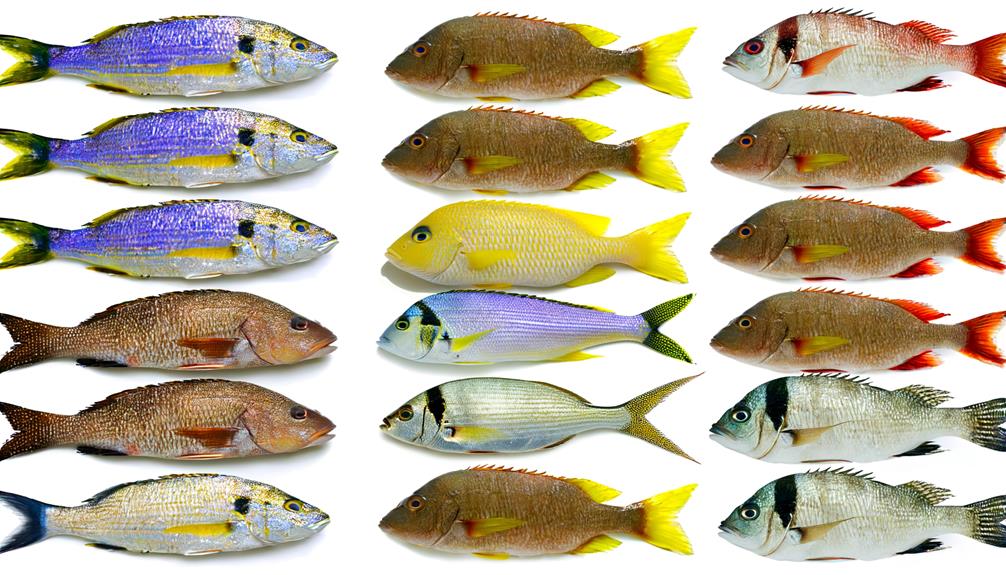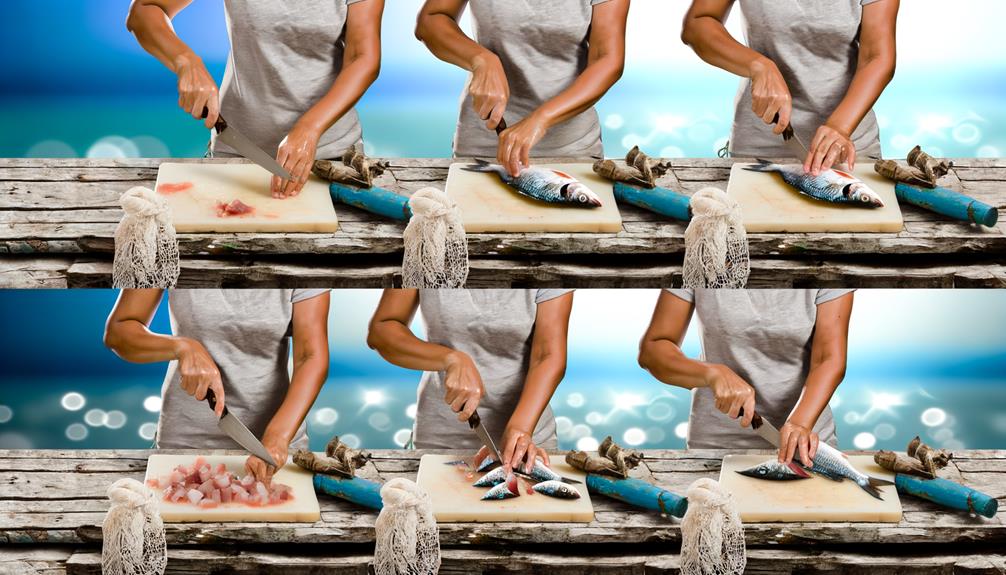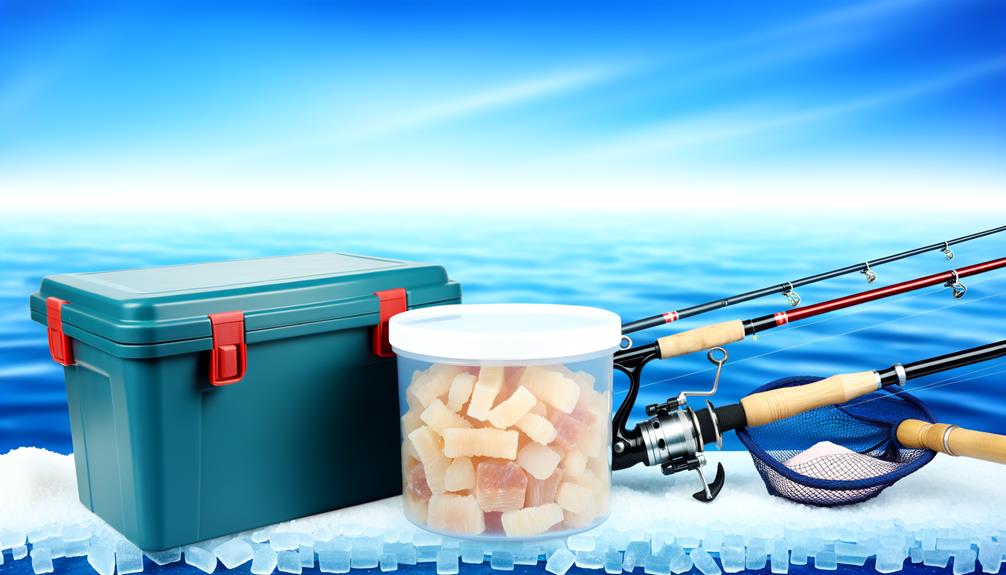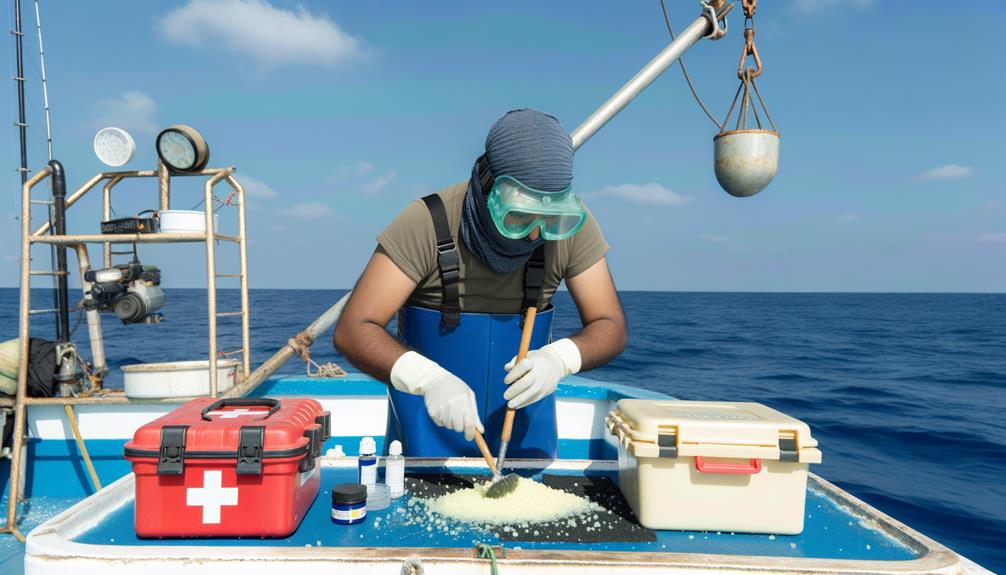The art of creating chum for saltwater fishing can significantly elevate your catch rate, making it an essential skill for any serious angler. While pre-made chum can be convenient, there's much to be said for the cost-effectiveness and satisfaction of making your own.
A well-crafted chum, utilizing ingredients like leftover Ballyhoo, pilchards, and Bonito, supplemented with steamed oats, fish food, and Menhaden oil, can have a dramatic impact on your fishing success. But how does one go about creating such a concoction, and what are the key considerations in terms of preparation, storage, and usage?
Let's explore this intriguing aspect of angling further.
Key Takeaways
- Effective chum for saltwater fishing can be made using ingredients like Ballyhoo, pilchards, and Bonito, enhanced with oats and Menhaden oil.
- Chumming techniques such as slicks and groundbait are crucial for attracting different fish species; adjust chum amount and frequency based on water conditions.
- Tailoring your chum to target specific fish species and adapting to seasonal variations can greatly enhance your fishing success.
- Proper storage of chum in labeled, gallon-sized freezer bags and adherence to safety precautions during preparation and use are essential for a successful fishing session.
Understanding the Basics of Chumming
While it may seem relatively straightforward, understanding the basics of chumming is key to enhancing your saltwater fishing experience, as it involves the strategic dispersion of a bait and scent mixture in the water to attract a variety of fish species to your desired fishing spot. The benefits of chumming are manifold, not least of which includes an increased chance of a successful catch. By creating a scent trail with the oils in the chum, fish are drawn towards your baited hooks, making them easier to target.
Commonly used in saltwater fishing, chumming serves as a potent tool to lure fish closer to the surface or to a specific area, thus simplifying the task at hand. The fish species you're targeting and the prevailing fishing conditions should dictate the type of chum you use. This approach fosters a sense of control and mastery over the fishing process, thereby enhancing the overall experience.
While chumming is highly effective, alternatives exist for those who may wish to experiment with different techniques. These include using live bait, lures, or fly fishing, among others. Regardless of the method, understanding the basic principles of attracting and targeting fish remains paramount to a successful saltwater fishing outing.
Ingredients Needed for Chum
Having explored the fundamental aspects of chumming, it is imperative to consider the necessary ingredients for creating an effective chum mixture for saltwater fishing. Essential components mainly include leftover Ballyhoo, pilchards, and Bonito. These fish species are typically abundant and can be acquired easily, making them the core ingredients of any chumming concoction.
However, the chumming techniques can be enhanced by introducing other components to the mixture. Steamed oats, Menhaden oil, and Purina tropical fish food are remarkable additives that can significantly improve the chum's efficacy, thus boosting your fishing success.
Preparing the chum also requires the right tools. A Sun Joe 15 amp wood chipper is a reliable machine to chop up the bait into smaller, more manageable pieces. Once the ingredients are adequately mixed in a bin, packing the chum into gallon bags for proper storage is recommended.
Proper storage in the freezer ensures the chum remains fresh for future fishing trips. This practice provides a cost-effective and convenient solution for avid anglers. It's essential to note that the choice of ingredients may vary due to seasonal variations, which will be discussed in the next section.
Choosing the Right Fish Species

When preparing chum for saltwater fishing, the selection of the right fish species significantly affects the outcome. It is important to understand the ideal types of fish to use, the impact of seasonal variations on these choices, and the potential effects on the local ecosystem.
Therefore, careful consideration of these factors is crucial in ensuring successful chum preparation and effective fishing.
Selecting Ideal Fish Types
In order to create an efficient chum for saltwater fishing, it is crucial to select the appropriate types of fish, with oily varieties such as Ballyhoo, pilchards, and Bonito being preferred choices. This fish selection directly impacts your chum's effectiveness, as these oily species release more scent and oils into the water, thereby attracting a wider variety of saltwater fish.
Additionally, consider enhancing your chum with menhaden oil for an added scent boost. It's also beneficial to select fish species commonly found in the area where you plan to fish. Remember, different species attract specific types of saltwater fish, so tailor your selection based on your target species, and enjoy the increased camaraderie and shared success within your fishing community.
Understanding Seasonal Variations
Mastering the art of seasonal variations plays an integral role in selecting the right fish species for crafting effective chum. Different fish species exhibit unique behaviors and feeding patterns during specific seasons, making it crucial for anglers to understand these seasonal preferences.
For instance, summer fishing calls for chum made from oily fish like mackerel, attracting predatory species such as tuna and mahi-mahi. Conversely, winter fishing may necessitate chum with a higher protein content, enticing bottom-dwelling species like snapper. By matching chum to these feeding patterns, one can significantly enhance their fishing success.
Adapting your chum recipe to these variations, therefore, is an essential skill in the art of chum making.
Impact on Local Ecosystem
Taking into account the local ecosystem's delicate balance is paramount when selecting the appropriate fish species for chum. Ecosystem preservation and sustainability practices should be at the forefront of your decision-making process.
- Opt for sustainable fish species like Menhaden or Ballyhoo; these not only minimize the environmental impact but also prove effective in attracting native fish.
- Avoid invasive species in your chum mixture to prevent potential harm to the marine environment.
- Consider the feeding habits and preferences of local fish species to enhance your chum's effectiveness.
- Always research local regulations and guidelines to ensure your chum-making practices support the health of the saltwater ecosystem.
Preparing the Fish for Chum

How do you prepare fish for chum, you might ask? Capitalize on your leftover Ballyhoo, pilchards, and Bonito to concoct a nutrient-dense chum blend. These saltwater fish are not only rich in oils that attract larger fish species, but they also provide the necessary nutrients to sustain them. It's all about making the most of what you have and contributing to a sustainable fishing community, where nothing goes to waste.
Fish processing doesn't have to be an arduous task. With the right equipment, such as the Sun Joe 15 amp wood chipper, you can efficiently chop up your leftover fish into the perfect size for your chum mixture. This high-powered chipper not only reduces waste but also ensures that every piece of fish contributes to a well-mixed chum consistency.
The texture of your chum is just as important as its composition. It needs to be thick enough to hold together, yet loose enough to disperse in the water and attract fish. Achieving this balance may take some practice, but with diligent stirring and a keen eye for detail, you'll soon master the art of making the perfect chum for your saltwater fishing adventures.
Mixing Additional Ingredients
In the process of creating a potent chum mix, incorporating additional ingredients such as Purina tropical fish food can significantly enhance the attractant properties and nutritional value of the blend. The infusion of such elements brings forth both flavor enhancements and nutritional benefits that make the mix irresistible to saltwater fish.
To further optimize your chum mix, consider the following steps:
- Incorporate fish oils, shrimp paste or other flavorings to intensify the scent of the chum, thus improving its attractant options.
- Exploit the nutritional benefits of additional ingredients like fish meal to boost the overall appeal of your chum mixture.
- Adjust the texture of the mix according to your needs. This can be done by adding water gradually, allowing for texture adjustments that suit different fishing scenarios.
- Experiment with different combinations of ingredients. It's this personal touch that creates a sense of belonging among fishing communities, with each angler boasting their own signature chum recipe.
Storing Your Homemade Chum

After perfecting your unique chum recipe and achieving the desired texture, the next crucial step involves proper storage to ensure the freshness and effectiveness of your homemade chum. The importance of chum storage cannot be overstated. Improper storage can lead to spoilage and compromised effectiveness.
Begin by portioning your chum into gallon bags. This not only maintains its freshness but also prevents spoilage. Ensure you label each bag with the date of preparation. This simple step will enable easy tracking and use of your chum batches.
Freezer organization is another key aspect of chum storage. Proper organization of your chum bags in the freezer helps to maximize storage space.
Before using your chum, thaw it in the refrigerator to ensure its consistency and effectiveness are maintained. Also, make a habit of rotating your chum bags regularly to use older batches first. This will help maintain a consistent supply of fresh chum.
| Storage Step | Importance | Tips |
|---|---|---|
| Portioning | Maintains freshness and prevents spoilage | Use gallon bags |
| Labeling | Enables easy tracking | Date of preparation |
| Freezer Organization | Maximizes storage space | Regular rotation |
| Thawing | Maintains consistency and effectiveness | Thaw in the refrigerator |
Best Chumming Techniques
Mastering the art of chumming can significantly increase your success rate in saltwater fishing.
Firstly, we will explore effective chumming strategies involving aspects such as the ideal chum consistency, chum deployment techniques, and the best times to chum.
Then, we will provide some tried and tested recipes for homemade chum that have proven effective in attracting various saltwater fish species.
Effective Chumming Strategies
To maximize the effectiveness of your saltwater fishing efforts, it is essential to understand and implement various chumming strategies, each with its unique characteristics and advantages. Mastering these techniques and utilizing the right chumming equipment can enhance your fishing experience.
- Utilize a variety of chumming methods: Deploying slicks, chunks, and groundbait targets different species effectively.
- Monitor and adapt: Observing fish behavior and adjusting your chumming strategy can lead to increased success.
- Modify frequency and amount: Adjust the amount and frequency of chum based on water conditions and target species.
- Optimize size, consistency, and scent: The characteristics of your chum play a vital role in attracting different fish types.
Follow these chumming tips for a more fruitful saltwater fishing expedition.
Homemade Chum Recipes
Creating your own homemade chum not only allows you to tailor the mixture to your specific saltwater fishing needs, but it also provides a cost-effective solution that can save you a significant amount of money compared to purchasing pre-made chum blocks.
For a potent attractant, chipper up leftover bait such as pilchards, Ballyhoo, and Bonito. Enhance the appeal by mixing in ingredients like steamed oats and Menhaden oil, thus broadening your bait selection.
For optimal chumming techniques, blend all components thoroughly in a bin for effective dispersal. Chum storage is simplified by freezing in gallon bags extending its usability. This practice can save anglers up to $140, underscoring the cost savings of homemade chum.
Safety Precautions While Chumming

Implementing safety precautions while chumming is essential, starting with the use of protective gloves to shield your skin from potential irritants in the chum ingredients and oils. Ensuring safety is paramount to not only prevent accidents but also to promote a harmonious environment for the fishing enthusiast.
To further establish a safe environment, it is advisable to:
- Use a mask or face shield to prevent inhalation of chum particles and odors, especially when working in confined spaces.
- Keep your chum-making area well-ventilated to avoid the buildup of fumes and ensure safer breathing conditions.
- Store chum bags securely in a freezer to avoid accidental spills or unwarranted exposure, particularly to pets and children.
- Dispose of chum waste appropriately to avoid attracting unwanted wildlife or causing environmental pollution.
These precautions serve to augment your fishing experience, making it safer and more enjoyable. They are not just safety measures, but also a way of showing respect for the environment and the wildlife that inhabit it. Remember, fishing is not just about the catch, it's about the experience, the camaraderie, and the respect for nature.
Evaluating Your Chumming Success
While ensuring safety is vital during the chumming process, it's equally essential to evaluate the success of your chumming efforts in order to refine your technique and enhance your fishing experience. Assessing success involves monitoring fish activity and behavior near the chum slick. This allows you to gauge the effectiveness of your chum in attracting fish.
Observing the rate of fish bites and catches after chumming helps in measuring impact. If you notice a significant increase in fish bites and catches, it indicates that your chumming technique is effective.
Further, consider the size and variety of fish attracted to the chum. This will assist in assessing its appeal to different types of fish.
| Measure of Success | Method of Evaluation |
|---|---|
| Fish Activity | Monitor behavior near chum slick |
| Bite Rate | Compare before and after chumming |
| Fish Variety | Observe species attracted to chum |
| Duration | Measure fish presence in chummed area |
Lastly, keep track of the amount of chum used versus the results obtained. This will help refine your chumming techniques, ensuring you're part of a community of successful saltwater fishermen.
Frequently Asked Questions
How to Make Your Own Chum?
To create your own chum, process leftover baitfish and mix with steamed oats and Menhaden oil. The chum consistency should be thick. Store this mixture in gallon bags and freeze for effective chum storage.
What Are the Ingredients for Chum?
Chum ingredients comprise Ballyhoo, pilchards, Bonito, enhanced with Menhaden oil. Steamed oats provide binding, while Purina tropical fish food adds nutritional value. Ingredient alternatives and chum preservation techniques ensure a potent mix for successful saltwater fishing.
What Makes Good Chum Bait?
Good chum bait is characterized by a blend of oily fish and enhancing ingredients, ensuring consistency and effective scent distribution. The bait's attraction factors rely on its ability to breakdown and disperse, luring diverse saltwater species.
What Kind of Oats for Chum?
When examining oat varieties' suitability for chum, steamed oats are preferred. These oats blend well, maintaining consistency, absorbing flavors effectively, and their nutritional impact enhances their attractiveness to fish, creating an inclusive fishing experience.
Conclusion
In summary, the art of chumming, while seemingly unrefined, requires both knowledge and skill.
This process juxtaposes the crude use of a wood chipper with the finesse of ingredient selection, creating a potent and cost-effective tool for saltwater fishing.
The irony lies in the seemingly simple process that transforms everyday waste into a valuable fishing asset.
Thus, chumming is not merely a task, but an art form, steeped in the practical wisdom of seasoned anglers.


